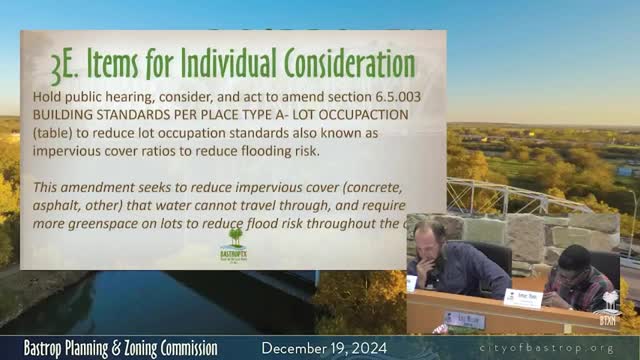Council evaluates amendments to reduce impervious cover and enhance green space in Bastrop
December 19, 2024 | Bastrop, Bastrop County, Texas
This article was created by AI summarizing key points discussed. AI makes mistakes, so for full details and context, please refer to the video of the full meeting. Please report any errors so we can fix them. Report an error »

In a pivotal meeting on December 19, 2024, the Bastrop Planning & Zoning Commission gathered to address pressing concerns about flood risk and urban development in the city. The atmosphere was charged with urgency as members discussed a proposed amendment aimed at reducing impervious cover—surfaces like concrete and asphalt that prevent water absorption—while increasing green space across residential lots.
The commission's focus on impervious cover stems from a recent history of flooding in the area, which has prompted a reevaluation of existing codes. Currently, maximum lot coverage is set at 60% for P3 zones, 70% for P4, and an unprecedented 80% for P5. The proposed changes seek to revert these figures to 50% for single-family areas, a move that advocates argue is essential for improving water management and reducing runoff.
One commission member passionately highlighted the correlation between increased impervious surfaces and flooding, citing data that shows a 3.3% rise in annual floods for each percentage point increase in impervious cover. The urgency of the situation is underscored by the city's proximity to the Colorado River, which has seen flood lines shift closer to developed areas due to changing climate patterns.
The discussion also touched on the challenges of maintaining drainage systems, particularly in older neighborhoods lacking underground infrastructure. As development continues, the need for effective stormwater management becomes increasingly critical. The commission is considering requiring developers to implement water retention solutions, such as detention ponds, to manage runoff effectively.
Public input was welcomed, with local resident Pablo Serna advocating for the inclusion of water harvesting systems and the differentiation of impervious cover limits based on lot size. His suggestions reflect a growing awareness of sustainable practices that could mitigate water issues while accommodating new development.
As the meeting progressed, the commission explored potential incentives for developers who incorporate rainwater collection systems into their projects. This could not only help manage water runoff but also reduce overall water consumption, a pressing concern in Texas. However, questions arose about the enforceability of such incentives, particularly regarding long-term compliance.
The commission ultimately decided to approve the amendment to reduce impervious cover while directing staff to develop a framework for incentives related to water conservation. This proactive approach aims to balance the need for development with the imperative of protecting the community from flooding, ensuring that Bastrop remains a resilient and sustainable place to live.
As the meeting concluded, the commission left with a renewed commitment to safeguarding the city’s future, recognizing that thoughtful planning today can prevent the flooding crises of tomorrow. The discussions set the stage for a more sustainable Bastrop, where green spaces flourish alongside responsible development.
The commission's focus on impervious cover stems from a recent history of flooding in the area, which has prompted a reevaluation of existing codes. Currently, maximum lot coverage is set at 60% for P3 zones, 70% for P4, and an unprecedented 80% for P5. The proposed changes seek to revert these figures to 50% for single-family areas, a move that advocates argue is essential for improving water management and reducing runoff.
One commission member passionately highlighted the correlation between increased impervious surfaces and flooding, citing data that shows a 3.3% rise in annual floods for each percentage point increase in impervious cover. The urgency of the situation is underscored by the city's proximity to the Colorado River, which has seen flood lines shift closer to developed areas due to changing climate patterns.
The discussion also touched on the challenges of maintaining drainage systems, particularly in older neighborhoods lacking underground infrastructure. As development continues, the need for effective stormwater management becomes increasingly critical. The commission is considering requiring developers to implement water retention solutions, such as detention ponds, to manage runoff effectively.
Public input was welcomed, with local resident Pablo Serna advocating for the inclusion of water harvesting systems and the differentiation of impervious cover limits based on lot size. His suggestions reflect a growing awareness of sustainable practices that could mitigate water issues while accommodating new development.
As the meeting progressed, the commission explored potential incentives for developers who incorporate rainwater collection systems into their projects. This could not only help manage water runoff but also reduce overall water consumption, a pressing concern in Texas. However, questions arose about the enforceability of such incentives, particularly regarding long-term compliance.
The commission ultimately decided to approve the amendment to reduce impervious cover while directing staff to develop a framework for incentives related to water conservation. This proactive approach aims to balance the need for development with the imperative of protecting the community from flooding, ensuring that Bastrop remains a resilient and sustainable place to live.
As the meeting concluded, the commission left with a renewed commitment to safeguarding the city’s future, recognizing that thoughtful planning today can prevent the flooding crises of tomorrow. The discussions set the stage for a more sustainable Bastrop, where green spaces flourish alongside responsible development.
View full meeting
This article is based on a recent meeting—watch the full video and explore the complete transcript for deeper insights into the discussion.
View full meeting
